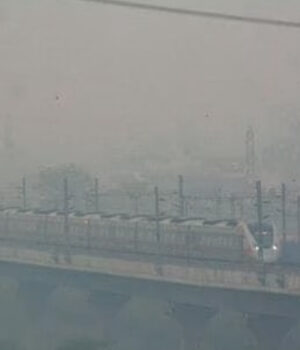Delhi, November 3, 2023 – The Commission for Air Quality Management (CAQM) in Delhi took a significant step on Thursday, implementing Stage 3 of the city’s Graded Response Action Plan (Grap) in a bid to combat the worsening air pollution crisis. The city found itself shrouded in a thick haze that persisted on Friday, with air quality deteriorating to alarming levels.
A day after Delhi’s air quality dipped into the “severe” category for the first time this season, the situation only worsened, with an average Air Quality Index (AQI) of 464 recorded at 8 am on Friday. Areas like Mundka and Bawana came perilously close to reaching the highest AQI limits at 498 and 496, respectively, by 7:05 am. Except for Dilshad Garden, which recorded an AQI of 367, all other monitoring stations reported “severe” air quality. In nearby regions, Greater Noida recorded an AQI of 473, and Faridabad reported an AQI of 442. The rapid decline in air quality, coupled with dense fog, reduced visibility to 600 meters at Safdarjung and 500 meters at Palam.
The situation prompted the closure of schools for students in Classes 5 and below on Friday and Saturday, as pollution levels reached alarming levels. The spike in pollution was triggered by Delhi recording a 24-hour average AQI of 392, just shy of the “severe” mark, at 4 pm. By midnight, the average AQI had surged to 427, with Mundka (453) and Anand Vihar (449) reporting the worst air quality.
Greater Noida, on Thursday, emerged as the most severely affected area in the National Capital Region (NCR), with an AQI reading of 402 at 4 pm. In contrast, Gurugram and Ghaziabad reported AQIs in the “poor” category at 297 and 286, respectively.
Delhi’s AQI was at 362 (“very poor”) on Wednesday, but calm surface-level winds exacerbated the impact of local pollution sources. Despite ongoing farm fires in Punjab and Haryana contributing to elevated PM2.5 levels, Delhi’s primary air quality issues were attributed to local pollutants within the city.
The CAQM implemented Grap Stage 3 in response to the escalating pollution crisis, which includes a ban on private constructions and demolitions, except for non-polluting activities such as plumbing, interior decoration, electrical work, and carpentry. However, critics argue that these measures are reactive rather than preemptive.
As farm fires and dropping temperatures loom, it is anticipated that the air quality in Delhi may continue to deteriorate in the lead-up to Diwali, which is just days away.










